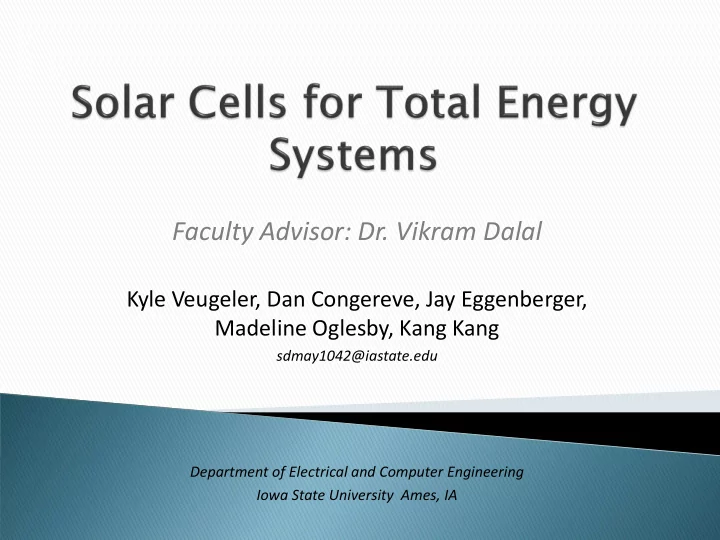

Faculty Advisor: Dr. Vikram Dalal Kyle Veugeler, Dan Congereve, Jay Eggenberger, Madeline Oglesby, Kang Kang sdmay1042@iastate.edu Department of Electrical and Computer Engineering Iowa State University Ames, IA
Abstract A solar ‘total energy’ system will provide both hot water and electricity from the same panel. To do this efficiently, it is necessary that the solar cells, deposited on heat transmitting substrates such as steel, work efficiently at elevated temperatures approaching 70‐80 ⁰C. Design In this project, we will fabricate and test the performance of amorphous and nanocrystalline tandem junction solar cells deposited on steel substrates as a function of temperature. We will measure and interpret the performance characteristics vs. temperature of such cells, and build a model that best explains and predicts such performance.
The cell must provide thermal heating for water and production of electricity from the same solar panel. The cell must work efficiently at high temperatures. Specifically 70‐80 ⁰C. Measurement and modeling of the performance must be done to further conclude the data analysis of the device.
The device must be placed on a thermally conducting substrate. Applications of “roll -to- roll” printing on steel is to be expected. Device must be made from nanocrystalline (nc-Si) and amorphous silicon (a-Si). Device must be made from non-toxic materials for environmental safety. Final device will be that of a thin film solar cell.
Our design is based on the notion that a-Si will perform better than c-Si at notably higher temperatures. Our tandem-junction configuration will perform much more efficiently, as opposed to that of a singular p-i-n or n-i-p junction. This is due to the increased wavelength absorption range that will be achieve by our tandem-junction design.
Minimum of 20 device runs @ 10 hours each. Operating cost of $20/hour = Minimum of $200 per device run. This yields approximately $4000 Thermocouples - $250 Our client has agreed to pay for the device runs, therefore the departmental cost will be ~$250.
Project Plan – Mid-October Device Designs – December 1 st Begin Initial Device Runs (5 Runs) – Mid-December 15 Additional Runs – January through Mid-February Device Testing – March Device Evaluation and Data Analysis – End of March
Recommend
More recommend